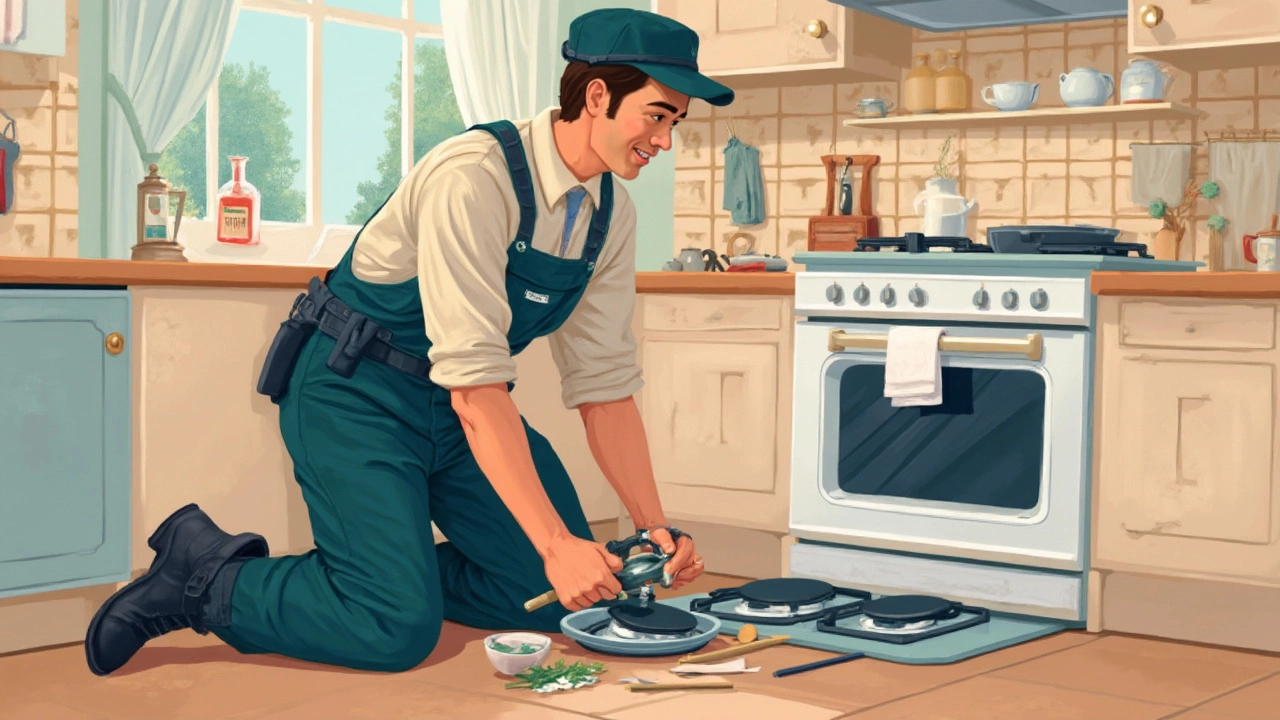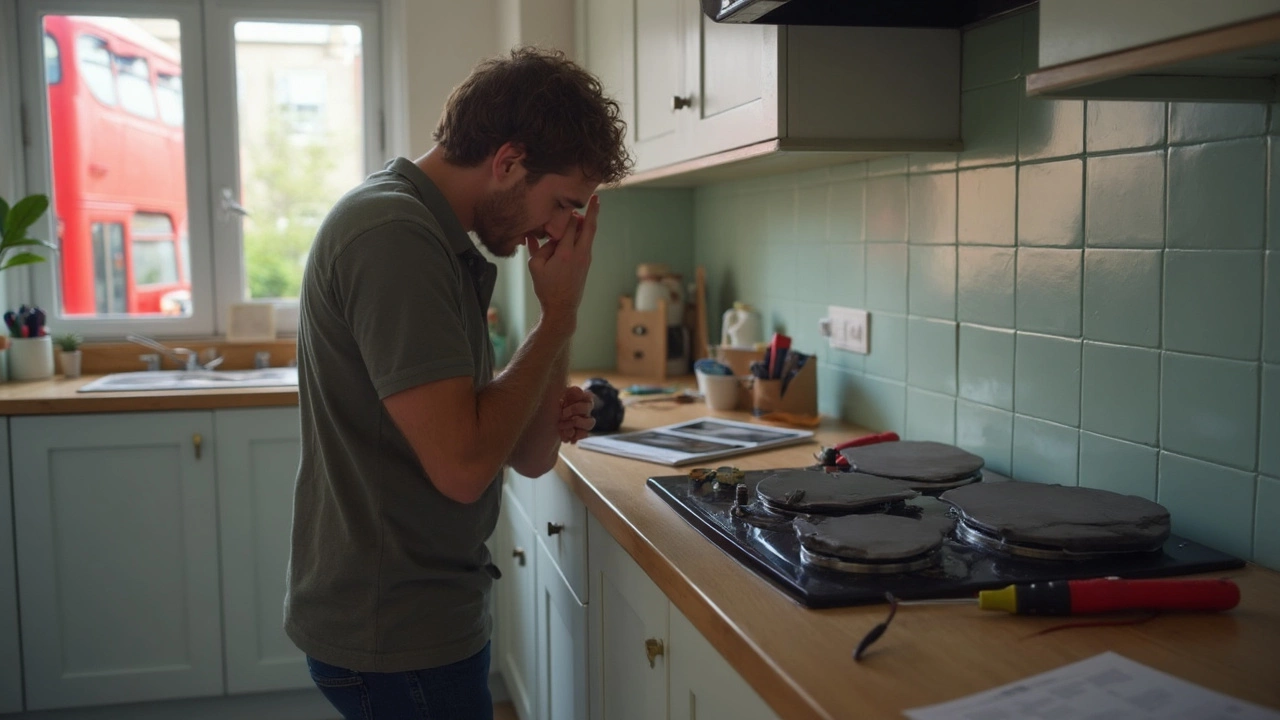First things first—if your hob has stopped working, don’t panic. Most hobs, whether electric or gas, can be repaired unless they’re super old or have taken some serious damage. The fix might be a quick button swap, a new burner, or something that needs a bit more elbow grease. Knowing what breaks most often makes the whole process a lot less stressful.
Sometimes, the signs are obvious: a burner that won’t light, weird clicking sounds, or a hob that just refuses to heat up. Other issues are sneaky—a pattern of uneven heating, for example, or a dial that’s suddenly stuck. A lot of these problems sound bad, but with the right tools and a little know-how, you might be able to sort them out yourself. The key thing? Most hobs are designed with repairs in mind because replacement parts are big business. Manufacturers expect things like knobs, igniters, glass tops, and wiring to give out eventually.
- What Actually Breaks On a Hob?
- DIY Fixes You Can Try First
- When to Call a Professional
- How Much Do Repairs Really Cost?
- Tips for Avoiding Hob Breakdowns
What Actually Breaks On a Hob?
Hobs are one of the hardest-working appliances in the kitchen, but parts will wear out or break over time. Knowing what usually fails makes it easier to spot issues and plan repairs.
- Burners or elements: On gas hobs, burners might stop lighting because of blocked jets or faulty igniters. On electric hobs, heating elements can burn out, causing uneven or no heating at all.
- Igniters and spark modules: If your gas hob’s not clicking or lighting, the igniter or spark module is often the problem. They wear down with use or might stop working if they get wet.
- Knobs and controls: These get yanked, twisted, and splattered with food all the time. It’s common for them to crack, loosen up, or even break off.
- Switches and wiring: The electrical parts inside your hob handle a lot of current, and over years of use, wiring can fray, switches can stick, or contacts might corrode.
- Glass tops and surfaces: Ceramic and glass hobs look sharp, but a dropped pot can crack or shatter them. This is usually more of a safety issue than a heating one, but it needs quick attention anyway.
Here’s a quick glance at what typically fails and how often these issues come up, based on repair surveys from appliance techs:
| Part | Most Common Issue | Chance of Failure (Over 5-10 Years) |
|---|---|---|
| Burners/Elements | No heat or uneven heating | 45% |
| Igniter/Spark Module | No ignition or clicking | 35% |
| Knobs/Controls | Cracked, loose, or not working | 30% |
| Wiring/Switches | No power, tripping fuse | 20% |
| Glass Top | Cracks or shattering | 10% |
When you start noticing a problem with your hob, odds are high it's one of these parts acting up. Spotting which bit is giving you grief is the first step to a successful hob repair.
DIY Fixes You Can Try First
Before you pick up the phone for a repair service, there are a few fixes you can handle yourself—often with just a screwdriver and a bit of patience. Some problems are more common than you might think, and sorting them out can save you time and money.
- Hob repair sometimes starts with a simple reset. For electric hobs, switch off the appliance at the wall, wait a few minutes, and then turn it back on. This can clear minor faults caused by power surges or glitches in the control panel.
- If one burner on your gas hob won’t ignite, lift off the burner cap and clean around the base with a toothbrush or a pin. Sometimes food or grease blocks the holes, stopping gas from flowing. Make sure everything is dry before you try it again.
- When knobs get stiff, try pulling them off gently and clean out any buildup underneath. Push them back firmly—if that doesn’t work, you can order replacements online. Most knobs just slide onto a simple metal post.
- If nothing heats up at all on an electric hob, check the circuit breaker or fuse. Hobs have their own fuse, usually in a spur under the worktop. Flip it back on or replace it if it’s blown.
- Glass tops with cracks or chips should be left alone for the pros, but if it’s just dirty or stained, a baking soda paste can help remove stubborn marks. Never use metal scouring pads—you’ll scratch up the surface and make things worse.
The key is to work safely. Always unplug or disconnect the power before poking around, and with gas hobs, turn off the gas at the valve if you need to take anything apart. If you smell gas or see a spark where there shouldn’t be one, call a professional right away. For everything else, these simple fixes often do the trick and can keep your hob cooking without a fuss.

When to Call a Professional
Sometimes, jumping in with a screwdriver just isn’t smart—or safe. If your hob is sparking, smells like gas, or has electric parts exposed, it’s time to get a pro. Messing with gas lines or electric wiring without real experience can land you in trouble fast, not to mention voiding your warranty. Fixing modern induction hobs or any high-voltage electric hob is not a job for guesswork.
Here are some clear signs you should stop and call a professional for hob repair:
- Gas smell: Any hint of gas around your hob means you need to shut it off, clear the area, and call a gas engineer. This is not a DIY fix—there’s a real risk of fire or explosion.
- Persistent electrical problems: If circuit breakers trip when you use the hob, or you see sparks, the internal wiring could be faulty. Only a qualified electrician should touch these issues.
- Broken glass tops: Replacing the glass on a ceramic or induction hob sounds easy, but the panels are pricey, heavy, and often linked to sensors or controls underneath. Messing this up can wreck the whole appliance.
- Repeated ignition failure: If cleaning and basic checks don’t sort a stubborn gas igniter, the ignition module itself might need swapping. That’s a job for a specialist unless you know your way around gas appliances.
- Strange noises or burning smells: Clicking, buzzing, popping, or a burning odor can mean something deeper is wrong—usually with electronics or wiring. A technician can spot issues you can’t see.
Warranties usually require licensed pros for anything beyond simple part swaps, so check your paperwork before you lift a finger. Remember, spending a little to get it fixed properly now usually beats buying a new hob in a panic later. If you’re ever unsure, just ask yourself: would you let your friend try this in your kitchen? If the answer is no, pick up the phone and get someone qualified in.
How Much Do Repairs Really Cost?
Wondering what you'll have to shell out to get your hob working again? Cost can be all over the place, depending on what’s busted, the brand, and who you call. Here's the deal—some fixes only set you back the price of a replacement part, while others hit you with call-out fees, labor, and even a bit for speedy service.
Small jobs like swapping out a broken knob or cleaning out a blocked burner often cost less than a night out. Parts can start as low as $10-$20, and if you’re handy, that could be your total. But when you need a new element or the wiring’s fried, expect to pay more—especially if you want a certified repair guy handling it.
Here’s a handy table showing what people are actually paying in 2024 in the US and UK for common hob repair jobs:
| Repair Type | US Cost (Average) | UK Cost (Average) |
|---|---|---|
| Replace control knob | $20 - $40 | £15 - £30 |
| New heating element | $90 - $170 | £70 - £120 |
| Igniter replacement (gas) | $110 - $190 | £85 - £140 |
| Glass top repair | $250 - $400 | £180 - £350 |
| Complete wiring fault | $130 - $260 | £100 - £200 |
Besides parts, keep an eye out for those "call-out" fees. Most repair companies charge just to show up, somewhere between $50 and $100 (or £40–£80 in the UK). If you live in a big city, expect to pay a bit more for both parts and labor.
The big brands—think Bosch, Whirlpool, or Samsung—tend to have pricier parts, so if you’re rocking a fancy name, be ready for higher bills. Budget models usually mean more affordable fixes since basic parts are easy to find.
If the repair is going to cost over half the price of a new hob (that’s usually around $300 or £250), it’s worth pausing. Compare options. Sometimes, buying new makes more sense, especially for older hobs where future breakdowns are just around the corner.
Hot tip: always ask your repair guy for an estimate in writing before they start fiddling with anything. Don’t forget to check if the repair, or even your hob, is still under warranty. Free fixes do happen, but only if you ask!

Tips for Avoiding Hob Breakdowns
If you’d rather not mess with emergency hob repairs, a little care goes a long way. Most hob issues actually come from stuff you can prevent with some pretty basic habits.
- Clean spills fast: Food spills and sticky messes are the main cause of blocked gas burners and jammed controls. Wipe up anything that boils over before it hardens—it saves you a lot of scrubbing and avoids part failures later.
- Don’t use harsh cleaners: Super strong chemicals can damage the finish, and abrasive pads can scratch glass tops, both of which open the door to bigger problems. Stick to a damp cloth or a cleaner made for hobs.
- Check for blockages: On gas models, the tiny holes where flame comes through get clogged with grease or crumbs. Give them a look now and then. Unclog with a toothpick or a pin if you see any build-up—never use anything too big or you could break the holes.
- For electric hobs, keep the elements dry. Moisture can fry electrical components. Make sure everything’s completely dry after cleaning before you crank the power back up.
- Don’t slam pans down: It might feel satisfying, but dropping pans damages glass tops and can knock gas burners loose. Place them gently to avoid expensive repairs.
A lot of people don’t realize that letting little issues slide can actually make things a lot worse (and more expensive) later. If a knob starts sticking, or a burner seems weaker, fix it before it gets worse. Regular checks and cleaning keep your hob repair headaches to a minimum.
